Web Sites
iBlog
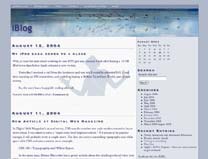
Started in March of 2000, this web log has served as a way for Mark to unleash his thoughts on an unsuspecting world. Updated almost daily during the week, Mark holds forth on topics as diverse as Macs, Web Standards and WiFi technology.
Ok, so maybe they’re not too diverse. But what can you say? Mark’s a geek through and through.
Real World Style
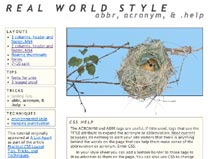
Let’s face it, in the real world there are still a significant number of people using antiquated browsers to surf the web. The Netscape 4 family just celebrated 5 years! I don’t know about you, but in my job upwards of 16% of our visitors are viewing our site using Netscape 4.x.
On Unix machines.
Frankly, this makes marking up documents with XHTML and using CSS2 for layout rather difficult at times. Fortunately for you, I’ve already put the hours in to making things work on these folks’ browsers of choice, and where things won’t work, I’ve figured out how to hide it.
These techniques work. I know, because I use them every day in my real world job.
National Optical Astronomy Observatory (NOAO)
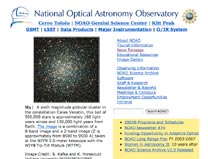
Mark is currently employed as NOAO’s Web Designer. Working with a team of back-end programmers, he is responsible for the look and feel of the site. Additionally, he has created a number of sub sites for various projects at the observatory, primarily in the areas of outreach and education.

The Spanish Language Astronomy Materials Education Center is a repository of reviews of resources for teaching astronomy in the Spanish language. This site is currently in development, awaiting it’s final URL (and a lot more content). The site is completely bilingual, with links on every page to the corresponding page in the other language. This is also all done with quite a bit of PHP trickery (and a little Apache trick thrown in for good measure). Each article has four files associated with it (two for each language). The PHP updates everything automatically based on the URL. Click around and you can probably figure out the naming scheme. And if you try to guess at a file name, and get it wrong, you’ll still get a reasonable page.
http://www.astronomyinspanish.org/ or
http://www.astronomiaenespanol.org/
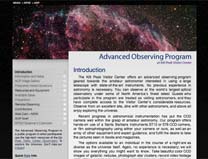
The Advanced Observing Program at the Kitt Peak Visitor Center is visited year round by amateur astronomers from around the world. Participants spend the night on top of Kitt Peak, home to the largest collection of optical telescopes in the world. During the night they take spectacular images of the Universe through one of the Visitor Center telescopes and take them home on CD.
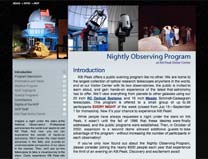
The Nightly Observing Program is a 3 hour program where larger groups (than the AOP) can be accomadated. Participants have the chance to view several beautiful objects in the night sky through one of the Visitor Center's telescopes.

The Resources for Astronomy Outreach Providers and Teachers of Native Americans site was developed to highlight and link to best practices for teaching astronomy and science to Native American students. Since Kitt Peak National Observatory resides on a mountaintop that is leased from the Tohono O’odham tribe, there is a particular focus on that group.

The Astronomy Education Review is the first and only refereed Astronomy Education Journal. It also happens to be completely web based. I designed the front end, and a colleague designed the back-end. We did this on essentially zero budget in our “free time.” Having caught the attention of the entire astronomical community, the project has now received some funding from NASA to continue its development.
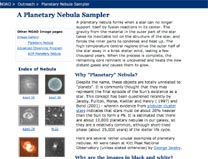
The Planetary Nebula Sampler has long been a source of hits for the NOAO web site. In its original form there was no where to go once you arrived, so we had as many people leave the site from this page as entered. We received a bit of money to do a redesign of the page, and I brought it into the era of web standards from the 1994 era design it started with. we continue to have a large number of web surfers enter here, but now they have somewhere to go if they want to continue to explore our site.
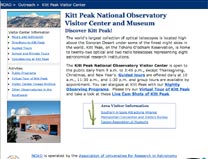
The Kitt Peak Visitor Center and Museum site acts as a gateway to the many options available for visitors to the nation’s largest collection of optical telescopes. Information on daily tours, nightly observing programs, volunteer opportunities and special programs all needed to be accessible and placed in an inviting context. This sub site provides the important information up front, while encouraging you to click around and find out more.

NOAO Press Releases are issued as important discoveries are made by our scientists and/or using our telescopes. The release that received the most attention was really more of a human interest story than anything else. On August 15-16, 2002 a couple of Yale University students images Asteroid 2002 NY40 just a couple of days before its close flyby of earth. The resulting digital movie was linked from the front page of Slash Dot, a popular web site for computer geeks. We had several thousand hits in a short period of time. And I’m happy to say that our servers handled the extra load just fine.
Magic of Tucson

In 1996 I created a web site for the local assembly of the Society of American Magicians. It was served from a tilde account at the University. Life being what it is, got real busy and I stopped updating the site late 1999. In 2003 we decided to get our own domain name, and the site has been resurrected as Magic of Tucson. It still bears the 1999 era frames and layout, but there are plans for making the site much more informative and useful to both the public and the magicians whom it serves.